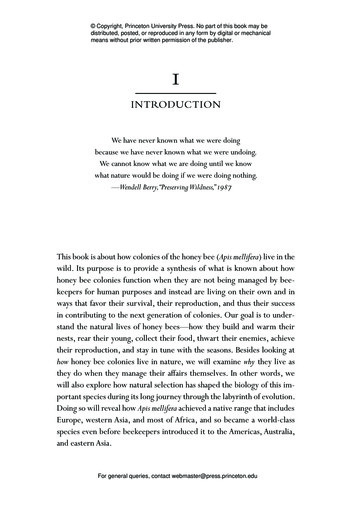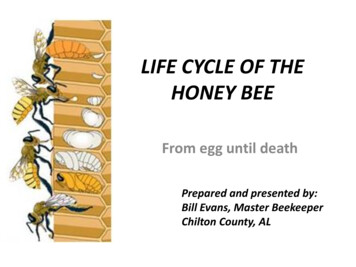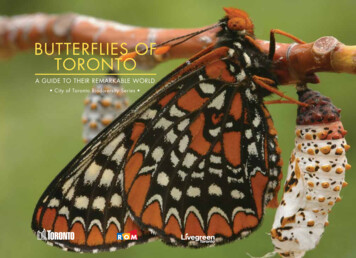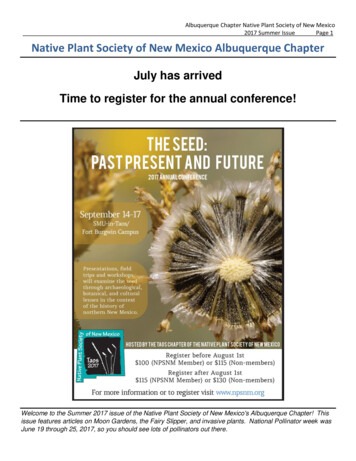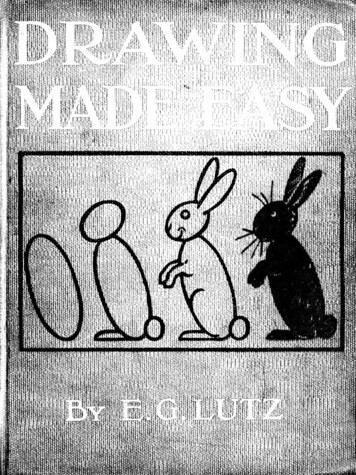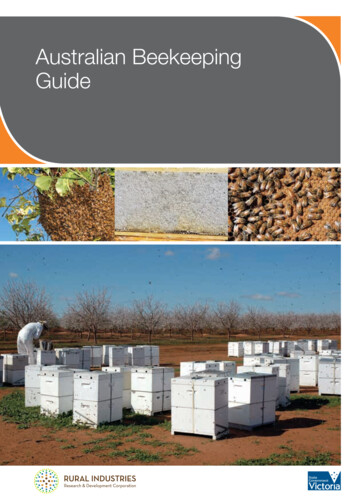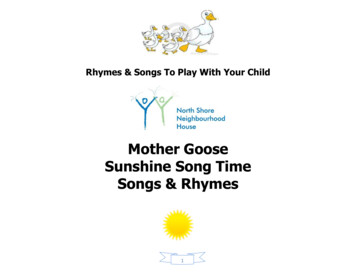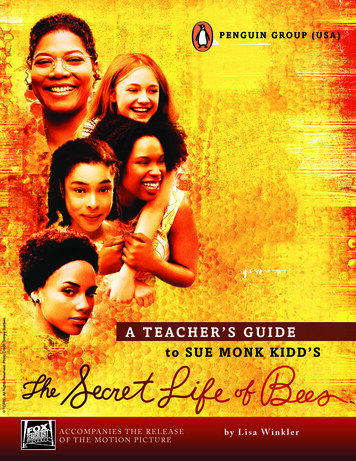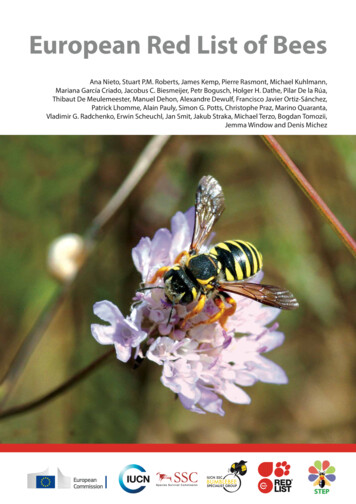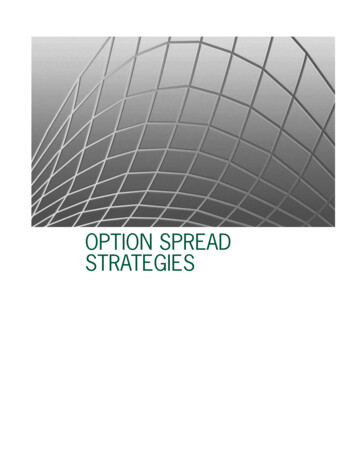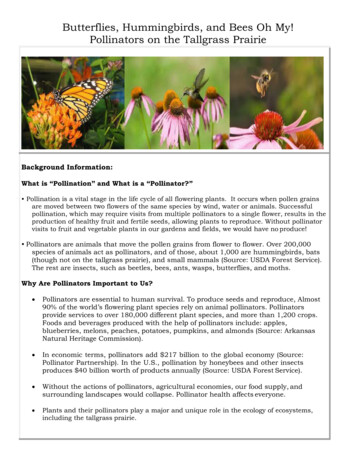
Transcription
Butterflies, Hummingbirds, and Bees Oh My!Pollinators on the Tallgrass PrairieBackground Information:What is “Pollination” and What is a “Pollinator?” Pollination is a vital stage in the life cycle of all flowering plants. It occurs when pollen grainsare moved between two flowers of the same species by wind, water or animals. Successfulpollination, which may require visits from multiple pollinators to a single flower, results in theproduction of healthy fruit and fertile seeds, allowing plants to reproduce. Without pollinatorvisits to fruit and vegetable plants in our gardens and fields, we would have no produce! Pollinators are animals that move the pollen grains from flower to flower. Over 200,000species of animals act as pollinators, and of those, about 1,000 are hummingbirds, bats(though not on the tallgrass prairie), and small mammals (Source: USDA Forest Service).The rest are insects, such as beetles, bees, ants, wasps, butterflies, and moths.Why Are Pollinators Important to Us? Pollinators are essential to human survival. To produce seeds and reproduce, Almost90% of the world’s flowering plant species rely on animal pollinators. Pollinatorsprovide services to over 180,000 different plant species, and more than 1,200 crops.Foods and beverages produced with the help of pollinators include: apples,blueberries, melons, peaches, potatoes, pumpkins, and almonds (Source: ArkansasNatural Heritage Commission). In economic terms, pollinators add 217 billion to the global economy (Source:Pollinator Partnership). In the U.S., pollination by honeybees and other insectsproduces 40 billion worth of products annually (Source: USDA Forest Service). Without the actions of pollinators, agricultural economies, our food supply, andsurrounding landscapes would collapse. Pollinator health affects everyone. Plants and their pollinators play a major and unique role in the ecology of ecosystems,including the tallgrass prairie.
Subject / grade level: Science – Tallgrass Prairie Pollinators / grades 4-12Materials: Prairie flowers of different colors, sizes, and shapes (Any flowers or pictures of flowers willalso work) Pollinators Meet Your Plants packet (1 per group) - copies of each page, folded in half andlaminated. This is at the end of this document. Flowers found on a hike at the Tallgrass Prairie National Preserve, near Strong City, KS.Important: No plant or animal specimens may be collected from the preserve!Extensions/Resources:An excellent PowerPoint slide show on pollinators and their importance:“Power of Pollinators” by Lindsay Rogers, Nebraska Game & Parks CommissionNebraska Project WILD is found at this s/2015/12/Power-ofPollinators.pdfA detailed “Pollinator Syndrome” table with many examples and information onplant/pollinator interactions from the North American Pollinator Protection Campaign canbe found at this link: http://www.pollinator.org/Resources/Pollinator Syndromes.pdfAn interactive webpage from the United States Department of Agriculture ForestService on pollination and nators/index.shtmlAn excellent resource for identifying Kansas wildflowers and grasses:http://www.kswildflower.org/Next Generation Science Standards:4-LS1-1, MS-LS1-4, HS-LS1-2Common Core State Standards Connections:ELA/Literacy – W.4.1, WHST.6-8.1, WHST.9-10.1, WHST.11-12.12
Lesson objective(s):Students will learn about pollinators found in the tallgrass prairie and their importance.Students will understand the interaction between prairie plants and their pollinators.ENGAGEMENTShow students the different flowers (or pictures) you have gathered. Ask them which one is theirfavorite. Have students write a paragraph in their notebook (or electronic device) stating theiropinion, supporting their point of view with reasons. Tell them to be prepared to share theirwriting with the class. Go around the room and have several students share which flower is theirfavorite and why.Explain to students that just like they prefer some flowers over others, so do pollinators. Forexample, because a butterfly has a long, slender mouth part (proboscis), they prefer flowers thatare long and tube-like. Some flies, on the other hand, have short, round mouth parts much like asponge. For these pollinators, a wide-open flower is preferred. Or, for other pollinators, likemoths, a flower that is open at night is preferred because that is when moths are active. Theconcept of pollinators preferring some plants over others is known as Pollinator Syndromes. Justlike we have symptoms or characteristics which are specific to a syndrome or illness, pollinatorshave characteristics that are specific to their preferred plants.Brainstorm with students the different kinds of pollinators that are found in the tallgrassprairie ecosystem - bees, butterflies, moths, beetles, ants, birds, (note: bats are not pollinatorsin tallgrass prairie ecosystems, they are in other parts of the world, including pollinatingsaguaro cactus in desert regions of the southwest United States). Answers should be gradelevel appropriate and can be written in their notebook or electronic device.EXPLORATION – Part I - In Class (Prefield trip)This activity can be done individually, in pairs or in small groups. Give eachstudent/group one “Pollinators Meet Your Plants” packet of cards. Explain to them thatthey are to use the characteristics of their pollinators and plants to find their match each plant has a specific pollinator. (Note: for several plants, the matching pollinator isnot the only pollinator to help pollinate this plant. Have students write their pairs in anotebook or electronic device.Once students have found their matches, have them write/type explanations for thepairings they chose. When all students are done with their explanations have themreport to the class their pairings/explanations and reasoning behind their answers.3
Exploration Part II – Field trip to Tallgrass Prairie National Preserve in ChaseCounty, Kansas (or other local prairie or natural area with flowering plants) Note:This activity must be done while flowers are blooming. This will vary with locationbut plants go dormant during winter on the Tallgrass Prairie National Preserve. Thebest time to observe flowers is early fall or late spring in Kansas and may vary fromyear to year. Call the preserve to ask if there are flowers blooming before youfinalize a date. Please educate yourself and your students on the venomous,poisonous and allergy inducing plants and animals that may be encountered onyour trip and be prepared for contact (rattlesnakes, poison ivy, ticks, mosquitos,bees etc.) with them. Be prepared for any allergic reaction and bring a first aid kit.Please identify students with severe bee sting allergies and make sure there is anEpipen close by. Also note: Please call ahead and schedule a day and time for yourfield trip at 620-273-8494 ext. 0. Bus tours of the prairie and tours of the historicaland cultural landmarks (ranch house, barn, and outbuildings) located at the preservemay be able to be scheduled with prior arrangement. Rangers will be able to answer anyquestions you may have as well as recommend other activities/events located here and inthe area.Field trip activities:Note: The Southwind Nature Trail offers easy accessibility, a variety of habitats and isnear the preserve visitor center but there are others to choose from.1) Instruct students to spend 10 minutes observing a flower or group of flowers. Havethem note types, numbers, and characteristics of pollinators that visit theirflowers. Tell students to stay on the trail and to not disturb the pollinators theysee. Have students regroup for discussion and instruction for part 2.2) Instruct students to find 5 - 10 plant/pollinator pairs while hiking one of the trails(The Southwind Nature Trail offers easy accessibility, a variety of habitats and isnear the preserve visitor center but there are others to choose from). They shoulddocument the flower and animal (insect) types. The details of which will vary withgrade level. For example, elementary students may describe insects such as bees,beetles, etc. while high school students may be required to document commonnames and or scientific names of the animals (insects) and plant interactionsencountered. They can also note what the pollinators hang on to while feedingand if a flower was visited by more than one type of pollinator. Students can alsonote the kinds of flowers that were bee-pollinated and conclude if those flowershad special characteristics (scent, certain color, size, etc.). You can also havestudents infer as to why a certain pollinator prefers a particular plant. Studentsmay need to make observations and do further research when getting back to theclassroom.3) When students are finished with the Field Trip Activity Sheet, instruct them toreflect on their time and experiences on the field trip. Have them answer thequestions on the Reflection worksheet. This can be done at the park, on thebus ride home, or upon returning to the classroom4
EXPLANATION Have students explain why they prefer a certain flower over the others. Students explain why they paired the pollinators and plants the way they did. Explain the animal/plant interactions observed on the field trip.ELABORATION Have students describe the plant/animal relationships they encountered on theirfield trip. Have students describe the general relationship between pollinator and flower.EVALUATION Students will demonstrate that they have achieved the lesson objective by theirverbal and written responses to the prompts for explanation of their pairings andby their understanding of the plant/animal relationships they encountered on thefield trip. Students should also have written notes and inference of the flower/pollinatorinteractions while on the trail. Students should reflect on the trip and write and draw observations made on theReflection worksheet.5
Field Trip Reflection1. Having visited the Tallgrass Prairie National Preserve, or other natural area, note below,things you noticed with your senses.2 things I saw2 things I heard2 things I smelled1 thing I touchedDid you taste anything?2. Draw a picture of something you saw today in the space below.Lesson plan adapted from: Pollinators, Meet Your Plants – Project Wild Nebraska –Nebraska Game and Parks Commission6
Pollinators Meet Your Plants - Activity Sheets7
Hummingbird I prefer flowers that are red in color. I do not land on the flower when drinking nectar,so I do not need a large landing spot. I seek flowers that are funnel shaped for mylong, slender beak. I want flowers with plenty of nectar. I need a lotof energy to flap my wings this fast!8
Bumble Bee I am able to regulate my own body temperaturethrough shivering and basking in the sun. Manyearly spring and fall blooming plants rely on me forpollination. I like to land on the flower when seeking nectar,I do not hover. Because I am a heavier pollinator, I pollinateplants that must “open” to reveal their nectar. I like lightly sweet smelling flowers.9
Regal Fritillary Butterfly I like flowers that grow in clusters so I haveplenty of room to land. I prefer brightly colored flowers, mainly red,yellow, and orange. I want flowers with lots of nectar. Because I have a long tongue, I often visitflowers with the nectar hidden deep inside.10
Ant I am not considered an important pollinator, butthere are millions of me and we do visit flowers, sowe do some pollinating. I cannot fly, so I visit flowers that are low to theground. I often visit flowers with small, inconspicuousflowers. I only pollinate during the day.11
Soldier Beetle As a beetle, I am an extremely importantpollinator beetles pollinate 86% of floweringplants. I often visit showy flowers and yellow in color. I am not too particular on the type of flowers. Ican pollinate large, solitary flowers like the stateflower of Kansas, the sunflower, or small, clusterflowers such as, yarrow.12
Hawkmoth Unlike most moths, I am crepuscular, so I visitflowers at dawn and dusk. I am often mistaken for ahummingbird. I want flowers that have ample nectar. And, withmy long tongue, I like the nectar to be hidden deepinside. I can be found feeding on hummingbird feeders,but I also like flowers that are purple, pink, white, oreven blue.13
Pollen Wasp I am a wasp yes, but I would prefer to visitflowers rather than sting you! My tongue is not nearly as long as most bees orbutterflies, so I need shallow flowers. I will visit a wide variety of flowers, but preferflowers from the Waterleaf and Figwort families.14
Bee Fly I am actually a fly that mimics a bee. I do not land on the flower when drinking nectarto avoid predators (like spiders) lurking on theflowers, so I do not need a large landing spot. I am often one of the first pollinators out in thespring. Although I do not land on the flowers I pollinate,I do get some pollen on my legs to pass to otherflowers.15
Leafcutter Bee I am a solitary bee, not a colony bee likebumble bees and honey bees. I am named because I chew perfect circles outof leaves. I use this material to seal my eggs in theirnest chamber. Although most leafcutter bees visit a widevariety of flowers, some species specialize inpollinating asters and pea flowers.16
Butterfly Milkweed I am brightly colored and have lots of smallflowers. this is called clusters of flowers. I can be found in a wide variety of habitatsincluding prairies, wetlands, and even roadsides.17
Snapdragon I can be found in a wide variety of colorsincluding yellow, white, pink, red, and orange. I must be “opened” . my large petal must bepushed down for pollinators to reach my nectar. I provide my pollinators with a large landingplatform. My nectar is at the bottom of a long tube.18
Honeysuckle I have no landing platform for my pollinators.I have a long funnel shaped flower.I can be red, white, yellow, or pink in color.I can grow as a bush or a vine.19
Goldenrod I have clusters of flowers. Although there are lots of kinds of Goldenrod,my flowers are always bright, showy yellow. I bloom in the late summer.20
Morning Glory I can be blue, white, deep pink, or pale pink incolor. I close my flowers at night, I open them firstthing in the morning. I am a common garden flower and can be foundclimbing on fences or trellises.21
Virginia Waterleaf I am a forest flower in Kansas. I grow low to the ground. My flowers are not too deep which allows manypollinators to get to my nectar.22
Spring Beauty I am one of the first wildflowers to bloom in thespring. My flowers can be white, pink, or even striped. I am a small plant and do not grow very tall.23
Wild Strawberry I grow low to the ground and am often visited bycrawling insects. I have small white flowers that are not veryshowy. I am usually found in shaded areas with plentyof indirect sunlight.24
Aster I am a small flower, but a single flower. I donot form clusters. I can be yellow, white, pink or purple in color. My petals are long and narrow, and althoughsmall, I have plenty of pollen and nectar.25
26
Pollinators are essential to human survival. To produce seeds and reproduce, Almost 90% of the world’s flowering plant species rely on animal pollinators. Pollinators provide services to over 180,000 different plant species, and more than 1,200 crops. Foods and beverag
